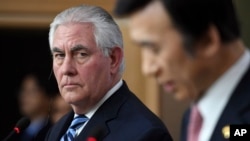The top U.S. diplomat Friday visited the heavily armed Demilitarized Zone, or DMZ, dividing North and South Korea.
U.S. Secretary of State Rex Tillerson is on the second leg of his Asia tour with his arrival in South Korea Friday. He is scheduled to meet with acting president Hwang Kyo-ahn and Tillerson's South Korean counterpart Yun Byung-se in Seoul.
Tillerson said Thursday in Tokyo on the opening leg of his first trip to Asia that “it is clear that a different approach is required” after 20 years of failed diplomatic efforts to prevent North Korea from having nuclear weapons.
The top U.S. diplomat said part of the reason he is in the region is to exchange views with Japan, South Korea and China on other ways forward.
“North Korea and its people need not fear the United States or their neighbors in the region who seek only to live in peace with North Korea,” Tillerson said at a joint news conference with Japanese Foreign Minister Fumio Kishida. “With this in mind, the United States calls on North Korea to abandon its nuclear and ballistic missile programs and refrain from any further provocations.”
Pledge to allies
He further pledged that U.S. commitment to defending Japan and other allies “is unwavering.”
The final leg of Tillerson’s tour is China, where his agenda includes a meeting with President Xi Jinping.
China's role
The secretary of state said Thursday China plays a very important role in efforts to encourage North Korea to abandon its nuclear program, and he encouraged China to fully implement U.N. sanctions meant to pressure the North Korean government.
“We will be having discussions with China as to further actions we believe they might consider taking that would be helpful to bringing North Korea to a different attitude about its future need for nuclear weapons,” Tillerson said.
Japan and South Korea, which host U.S. troops and are within range of North Korean missiles, support U.S. efforts to increase diplomatic and economic pressure on North Korea. A statement by the U.S. Navy’s 7th Fleet said the three allies were conducting drills Wednesday in seas east of the divided Korean Peninsula and north of Japan to promote interoperability.
Tillerson’s talks with Xi will also lay the groundwork for a summit between Xi and U.S. President Donald Trump, which is expected to take place in early April in Florida.
Media coverage limited
Only one reporter is traveling with Tillerson, instead of the usual larger group from news organization that traditionally have gone with the secretary of state.
Erin McPike of the conservative leaning website the Independent Journal Review, was chosen to travel with Tillerson on this trip. Under intense questioning from beat reporters Wednesday, acting State Department spokesman Mark Toner said McPike was selected by a group of decision makers in an attempt “to look at outside the box approaches to how we handle coverage of the secretary.”
Toner tried to reassure inquiring reporters the media will “have broad access” to Tillerson. He said 23 journalists, including 17 from the U.S., will have access during media availabilities.
But when asked if McPike will have access to Tillerson when other reporters will not, Toner could not respond definitively.
“I can’t speak to what additional access may be provided to this reporter,” he said.
The State Department originally said Tillerson would not take journalists with him because the plane he was traveling on was too small. He ended up taking a Boeing 737, which could have accommodated some of the regular agency reporters, each of whom is required to cover his or her own costs.












